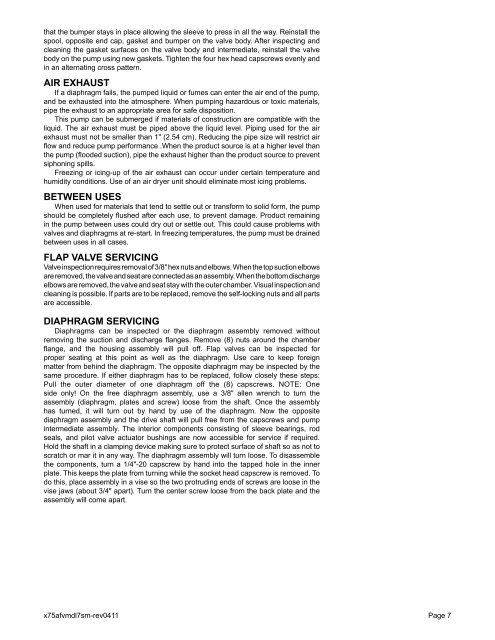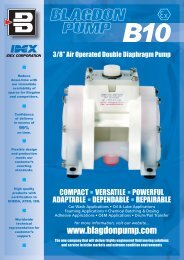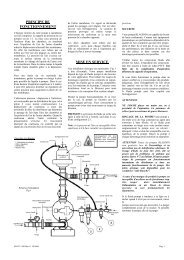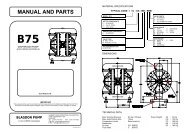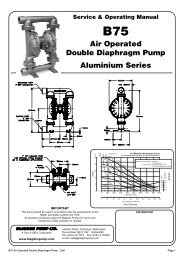X75 Aluminium Flap Valve Pump Design Level 7 - Blagdon Pump
X75 Aluminium Flap Valve Pump Design Level 7 - Blagdon Pump
X75 Aluminium Flap Valve Pump Design Level 7 - Blagdon Pump
Create successful ePaper yourself
Turn your PDF publications into a flip-book with our unique Google optimized e-Paper software.
that the bumper stays in place allowing the sleeve to press in all the way. Reinstall the<br />
spool, opposite end cap, gasket and bumper on the valve body. After inspecting and<br />
cleaning the gasket surfaces on the valve body and intermediate, reinstall the valve<br />
body on the pump using new gaskets. Tighten the four hex head capscrews evenly and<br />
in an alternating cross pattern.<br />
AIR EXHAUST<br />
If a diaphragm fails, the pumped liquid or fumes can enter the air end of the pump,<br />
and be exhausted into the atmosphere. When pumping hazardous or toxic materials,<br />
pipe the exhaust to an appropriate area for safe disposition.<br />
This pump can be submerged if materials of construction are compatible with the<br />
liquid. The air exhaust must be piped above the liquid level. Piping used for the air<br />
exhaust must not be smaller than 1" (2.54 cm). Reducing the pipe size will restrict air<br />
flow and reduce pump performance .When the product source is at a higher level than<br />
the pump (flooded suction), pipe the exhaust higher than the product source to prevent<br />
siphoning spills.<br />
Freezing or icing-up of the air exhaust can occur under certain temperature and<br />
humidity conditions. Use of an air dryer unit should eliminate most icing problems.<br />
BETWEEN USES<br />
When used for materials that tend to settle out or transform to solid form, the pump<br />
should be completely flushed after each use, to prevent damage. Product remaining<br />
in the pump between uses could dry out or settle out. This could cause problems with<br />
valves and diaphragms at re-start. In freezing temperatures, the pump must be drained<br />
between uses in all cases.<br />
FLAP VALVE SERVICING<br />
<strong>Valve</strong> inspection requires removal of 3/8" hex nuts and elbows. When the top suction elbows<br />
are removed, the valve and seat are connected as an assembly. When the bottom discharge<br />
elbows are removed, the valve and seat stay with the outer chamber. Visual inspection and<br />
cleaning is possible. If parts are to be replaced, remove the self-locking nuts and all parts<br />
are accessible.<br />
DIAPHRAGM SERVICING<br />
Diaphragms can be inspected or the diaphragm assembly removed without<br />
removing the suction and discharge flanges. Remove (8) nuts around the chamber<br />
flange, and the housing assembly will pull off. <strong>Flap</strong> valves can be inspected for<br />
proper seating at this point as well as the diaphragm. Use care to keep foreign<br />
matter from behind the diaphragm. The opposite diaphragm may be inspected by the<br />
same procedure. If either diaphragm has to be replaced, follow closely these steps:<br />
Pull the outer diameter of one diaphragm off the (8) capscrews. NOTE: One<br />
side only! On the free diaphragm assembly, use a 3/8" allen wrench to turn the<br />
assembly (diaphragm, plates and screw) loose from the shaft. Once the assembly<br />
has turned, it will turn out by hand by use of the diaphragm. Now the opposite<br />
diaphragm assembly and the drive shaft will pull free from the capscrews and pump<br />
intermediate assembly. The interior components consisting of sleeve bearings, rod<br />
seals, and pilot valve actuator bushings are now accessible for service if required.<br />
Hold the shaft in a clamping device making sure to protect surface of shaft so as not to<br />
scratch or mar it in any way. The diaphragm assembly will turn loose. To disassemble<br />
the components, turn a 1/4"-20 capscrew by hand into the tapped hole in the inner<br />
plate. This keeps the plate from turning while the socket head capscrew is removed. To<br />
do this, place assembly in a vise so the two protruding ends of screws are loose in the<br />
vise jaws (about 3/4" apart). Turn the center screw loose from the back plate and the<br />
assembly will come apart.<br />
x75afvmdl7sm-rev0411 Page 7


